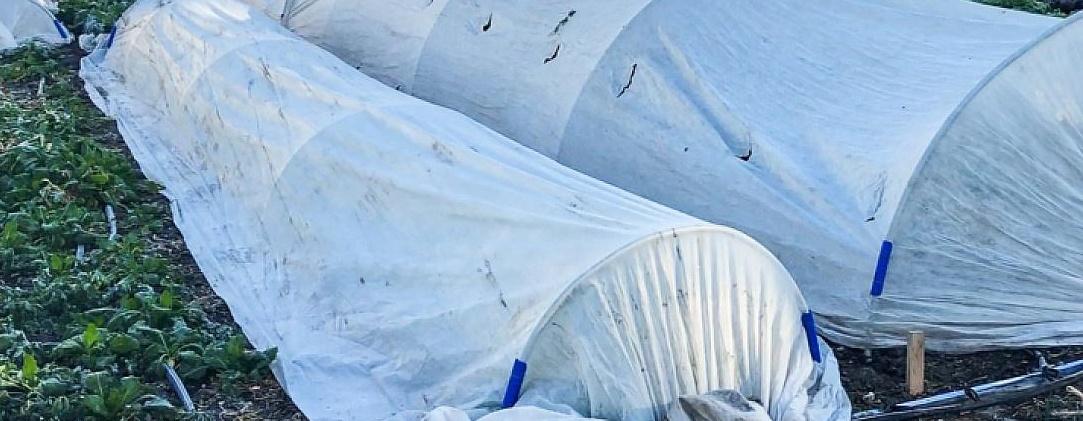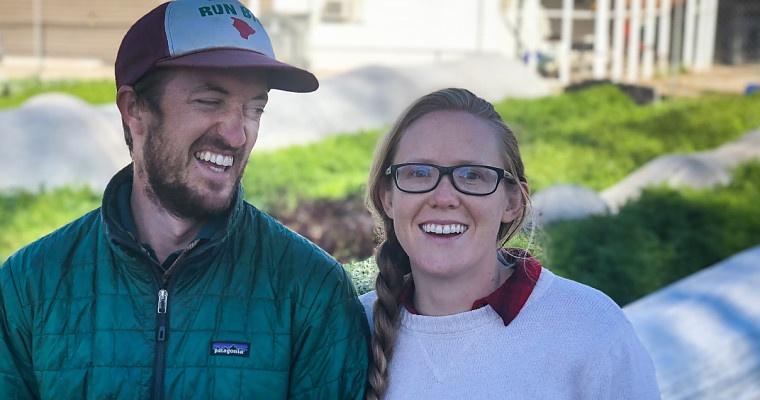How To Build Hoop Houses


If you have a home garden or planter boxes and want to continue growing food well into the winter, then building a hoop house—or “low tunnel” as they’re sometimes called—is just the project for you!
We visited with local urban farmers Elliott and Manda of Top Crops to learn more about hoop houses; how they’re used, what sorts of materials are needed, and some important tips on growing in the cold seasons.

Hoop houses are an easy way to extend the growing season by covering and protecting what’s already in the ground. These are usually plants that love the colder weather and can withstand the temperature change. Most common are greens and herbs, but you can also grow hardy veggies like carrots and beets. (A list of winter-hardy plants is at the bottom of this article.
- Manda Theobald
You’ll first want to measure your garden rows, or planter boxes, to determine the length of the hoop and the number of hoops you will need. The frost cloth or plastic should be about 2 or 3 feet from the ground at the apex of the hoop. You’ll also want enough room to be able to pull back your cover and easily reach in to cut or harvest your bounty.
Commonly used for the hoops are 1-inch PVC piping. It’s cheap and you don’t have to worry about bending it—it will bend when you bury each end in the ground. Electrical conduit also works well because it is stronger than PVC. However, because it’s sturdier, it’s also difficult to bend. Elliot built a custom tool to bend their 5-foot and 10-foot hoops.
Each end of the hoop will be placed in the ground about 6-8 inches deep. If you have a planter box all you must do is bolt it to your box.
Hoops should be spaced about 5-feet apart. It’s a good idea to reinforce the hoops with a center rod that runs the length between each hoop. This provides support for the cover in a snowstorm and helps secure the hoops. Top Crops uses a strap or rope that they tightly loop around each hoop and stake down on either end of the garden bed, like a tent.
Hoop house covers come in various widths to cover different hoop sizes. You will want enough material along each edge to cover your garden. An additional 6-10 inches on either side should be enough to weigh the edge down with sandbags or other weights.
Frost cloth is a great cover but will not hold up against snow. If a snowstorm is coming, reinforce your frost cloth with plastic. The frost cloth is easier to store during the warmer seasons because it can easily be rolled or folded. Make sure it’s clean and dry before storing it.
It’s recommended to use greenhouse-grade plastic because it’s designed to withstand extreme temperatures. The plastic sheeting at your local hardware store will work too, but will most likely start to crack and decay after the first winter season.
Invest in several sandbags or some form of weight to seal your tunnel off along the edge of your garden rows or beds. Make sure you get a weight that can be easily moved so that you can get to what you're growing.
Clamp the frost cloth or plastic to your hoops or center rod so it’s nice and snug. You can get away with using hardware store metal clamps. Manda and Elliott have used office binder clamps. There are also several companies that specialize in low tunnel clamps.
You’ll want to start your winter plants earlier than you think, in early to late August, in order to ensure that they will be big enough to survive and thrive once the frost hits. As the days get shorter the plant will stop growing, but it won’t die.
- Elliott Musgrove
You can start your plants indoors, in pots, or in growing trays, and then transplant them into the ground before the first frost. That way you don’t need to pull out your tomatoes early, for example, in order to get your winter garden growing. If you’re transplanting them, you’ll want the plant to harden off (acclimatize to the cooler fall weather) and get to a good size before planting it in your garden.
You can get your hoops in the ground early and then cover them just before the first frost. Covering your hoops depends on the weather; if you’re having a warm October you may as well let your plants get as much direct sun as possible.
- Manda Theobald
For most of Utah’s climate zones, you won’t need to water your hoop house garden very much. With the amount of precipitation during the fall and early winter and the lower ground temperature, the water doesn't evaporate as much, leaving enough for your plants. If the days stay warmer throughout October, you can hand water with your watering canister.
Because of the shorter daylight hours and the temperature difference, you will most likely only get one harvest out of your winter garden, so it’s a good idea to try and grow as much as possible. Fortunately, a lot of greens can be planted close together to maximize space and yield.
Below is a list of plants that can be grown in the winter. This year, Top Crops is growing unique Chinese greens like bok choy, mizuna, tatsoi, and a red mustard green variety called Scarlet Frills.
If you live in Utah and have a garden or garden project that you'd like to be featured on Modern Gardener, click here!